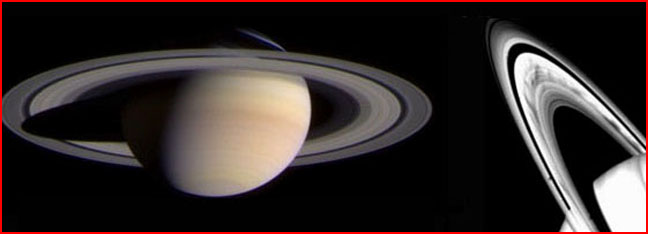|
|
||
 Credit: NASA/JP//SSI |
||
|
pic of the day Links:
Society for
|
Jul 06, 2004 When Voyager I and Voyager II flew past Saturn in Nov 1980 and Aug 1981, astronomers were surprised to see that the middle ring had dark "spokes". But when the more recent Cassini probe reached Saturn, astronomers were surprised again: the spokes were gone. The Electric Universe may explain this mystery. The spokes are caused by radial discharges from Saturnıs magnetosphere into the planetıs ionosphere. Such low-latitude discharges are observed in the laboratory when a magnetized sphere is immersed in an electrified plasma. In Saturnıs case, the rings provide a more easily ionized, "dusty" plasma that would tend to concentrate the discharges in the plane of the rings. The effect on the ring particles is to temporarily alter their polarization and to move them out of the plane of ring. This change in optical properties causes the "spokes" to appear. But why was Saturn's magnetosphere discharging then and not now? In 1980-81, the Sun's electric activity, the solar sunspot cycle, was at its maximum and Jupiter, Saturn and the sun were in a line. Today the solar cycle is approaching minimum and the planets are separated by about 75 degrees. We already know that the activity of solar maximum produces global electrical effects on Earth: the auroras brighten and move toward the equator, radio communications are disrupted, power grids and satellites may be affected. Are the spokes of Saturn another electrical expression of the solar cycle? Is Jupiter's giant magnetosphere, which stretches almost to Saturn's orbit, a factor? Since Cassini is scheduled to orbit Saturn for much longer than the brief fly-bys made by the Voyagers, it may observe the rings long enough to learn more about the relationship between Saturn's spokes, the solar electric cycle and the relative positions of the giant planets. Cassini's journey to Saturn promises new insights for the growing field of plasma cosmology. But there's another Saturn question related to the history of human culture. Saturn is the dimmest of the planets visible to the unaided eye. Few people today know how to find it in the night sky, and even Galileo's telescope-power was so low that the rings appeared only as ear-like extensions. In spite of this, ancient cultures cast Saturn in central role. They spoke of him as a supreme ruler, king of the sky, master of time, and lord of the rings. Can Cassini solve this mystery, too? |
|
|
Copyright 2004: thunderbolts.info |
||
